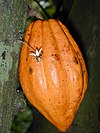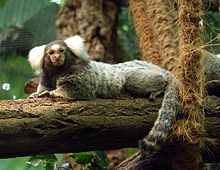초콜릿의 건강 영향
Health effects of chocolate초콜릿의 건강 영향은 건강에 미치는 가능한 긍정적인 영향과 부정적인 영향이다. 초콜릿 소비의 잠재적인 건강상의 이점을 평가하기 위해 상당한 연구가 진행되었지만, 효과를 확인할 수 있는 임상 연구 연구가 불충분하며, 어떤 의료나 규제 당국도 건강 주장을 승인하지 않았다.
역사
카카오 나무인 테오브로마 카카오가 플라보놀을 함유한 씨앗을 생산한다. 이 씨앗들은 중남미의 아즈텍, 올멕, 마야 문명에서 약 2000년 동안 음료를 만드는데 사용되어 왔다.[1] 그 음료들은 실험적인 증거에 의해 뒷받침되지 않는, 매우 다양한 치료 및 흥분제 성질로 간주되었다. 19세기에 고체로서의 초콜릿이 발명되었고, 우유와 설탕이 첨가되어 지방과 설탕이 많이 함유된 밀크 초콜릿을 만들었다. 때때로 초콜릿 산업에 의해 자금을 지원받기도 하는 의심스러운 연구는 때때로 이러한 제품들에 대한 가능한 건강상의 혜택에 대한 제안들을 해왔다.[2]
리서치
여드름
초콜릿 소비와 여드름의 관계를 결정하기에는 전반적인 증거가 불충분하다.[3][4] 다양한 연구들은 초콜릿이 아니라 설탕, 옥수수 시럽, 그리고 다른 간단한 탄수화물과 같은 특정 음식의 높은 당혈성을 다른 가능한 식이 요인과 함께 여드름의 잠재적 원인으로 지적한다.[3][4][5][6][3][7]
중독
초콜릿을 포함한 음식은 일반적으로 중독성이 있는 것으로 여겨지지 않는다.[8] 그러나 어떤 사람들은 초콜릿을 원하거나 갈망할 수도 있는데,[8] 이것은 스스로 초코홀릭이라고 부르는 용어로 이어진다.[8][9]
무드
일부 통속적인 신화에 따르면, 초콜릿은 성욕을 증가시키거나 인지력을 자극하는 것과 같은 분위기 강화제로 여겨지지만, 그러한 효과가 모든 초콜릿 소비자들 사이에서 일치한다는 과학적인 증거는 거의 없다.[10][11] 초콜릿 섭취로 인한 기분개선이 일어나면 카페인, 테오브로민, 또는 그들의 모분자인 메틸산틴과 같은 성분들의 자극제 효과에 의한 것인지 나타내는 연구가 충분하지 않다.[11] 2019년 한 리뷰는 초콜릿 소비가 우울한 기분을 개선하지 못한다고 보고했다.[12]
심장과 혈관
리뷰는 코코아 제품을 섭취해 혈압을 낮추는 단기적 효과를 뒷받침하지만 장기적 심혈관 건강상 이익에 대한 증거는 없다.[13][14] 매일 코코아 플라보올을 섭취하는 것(최소 용량 200mg)이 혈소판과 혈관 기능에 도움이 되는 것처럼 보이지만, 심장마비나 뇌졸중에 대한 영향을 뒷받침할 좋은 증거가 없다.[15][15][16]
리드 콘텐츠
비록 연구에 따르면 몸에 있는 낮은 수준의 납이 어린이들에게 해로울 수 있다고 하지만,[17][18] 적은 양의 초콜릿 섭취가 납 중독을 일으킬 가능성은 낮다. 일부 연구는 납이 코코아 껍질과 결합할 수 있고 제조 과정에서 오염이 발생할 수 있다는 것을 보여주었다.[19] 한 연구는 밀크 초콜릿 캔디 바의 평균 납 함유량이 사탕 1g당 0.027µg이라는 것을 보여주었고,[19] 또 다른 연구는 미국 슈퍼마켓에서 구입한 일부 초콜릿이 코코아 분말이나 콩의 납에 대한 국제(자발적) 기준치인 그램 당 1µg에 가까운 최대 0.965µg을 함유하고 있다는 것을 발견했다.[20] 2006년 미국 FDA는 사탕에서 허용되는 납의 5분의 1을 줄였지만, 준수는 자발적일 뿐이다.[21] 연구에 따르면, "초콜릿을 많이 소비하는 아이들은 일일 납 한계를 초과할 위험이 있는 반면, 다크 초콜릿 10g 한 입방체에는 일일 납 구강 한도가 20%에 이를 수 있다"고 한다. 게다가 초콜릿이 그들의 영양에서 유일한 납 공급원은 아닐 수도 있고,[22] "초콜릿은 특히 어린이들에게, Cd와 Pb 섭취의 중요한 원천일 수도 있다."[23]
폴리페놀 및 테오브로민 함량
초콜릿은 폴리페놀을 함유하고 있으며, 특히 플라반-3올(카테친)과 소량의 다른 플라보노이드를 함유하고 있는데,[24] 이 플라보노이드들은 체내에서 잠재적인 효과로 연구되고 있다.[25] 다음 표는 세 가지 다른 종류의 초콜릿에서 페놀, 플라보노이드, 테오브로민의 함량을 보여준다.[citation needed]
| 초콜릿의 종류 | 총 페놀러움수(mg/100g) | 플라보노이드 (mg/100g) | 테오브로민 (mg/100g) |
|---|---|---|---|
| 다크 초콜릿 | 579 | 28 | 883 |
| 밀크 초콜릿 | 160 | 13 | 125 |
| 화이트 초콜릿 | 126 | 8 | 0 |
인간이 아닌 동물
충분한 양으로 초콜릿에서 발견되는 테오브로민은 고양이, 개, 말, 앵무새, 작은 설치류 같은 동물들에게 독성이 있다. 왜냐하면 그들은 화학물질을 효과적으로 대사할 수 없기 때문이다.[26] 동물들에게 초콜릿을 먹이면 테오브로민이 최대 20시간 동안 순환에 머물러 간질 발작, 심장마비, 내출혈, 결국 사망에 이를 수 있다. 수의사가 시술하는 진료에는 발작에 대한 벤조디아제핀이나 바비투르테프, 심장 부정맥에 대한 부정맥 방지, 유체이뇨를 섭취한 지 2시간 이내에 구토를 유도하는 것이 포함된다.
일반적인 20kg(44lb)의 개는 보통 240g(8.5oz) 미만의 다크초콜릿을 먹은 후 큰 장고통을 겪지만, 밀크초콜릿 1.5kg(1.1lb)을 먹지 않는 한 반드시 서맥이나 빈맥이 생기는 것은 아니다. 다크 초콜릿은 테오브로민이 2~5배 더 많아 개에게 더 위험하다. 머크 수의학매뉴얼에 따르면 개 몸무게(0.02oz/lb)의 1kg당 약 1.3g의 제빵용 초콜릿이 독성 증상을 일으키기에 충분하다. 예를 들어, 전형적인 25그램(0.88온스)의 제빵용 초콜릿 바는 20킬로그램(44lb)의 개에게 증상을 일으키기에 충분하다. 20세기에는 카카오 열매껍질로 만든 멀치가 개와 가축에게 위험하다는 보고가 있었다.[27][28]
- ^ Dillinger, Teresa L.; Barriga, Patricia; Escárcega, Sylvia; Jimenez, Martha; Lowe, Diana Salazar; Grivetti, Louis E. (1 August 2000). "Food of the Gods: Cure for Humanity? A Cultural History of the Medicinal and Ritual Use of Chocolate". The Journal of Nutrition. 130 (8): 2057S–2072S. doi:10.1093/jn/130.8.2057S. ISSN 0022-3166.
- ^ Fleming, Nic (25 March 2018). "The dark truth about chocolate". The Observer. Retrieved 25 March 2018.
- ^ a b c Bhate, K; Williams, H. C. (2013). "Epidemiology of acne vulgaris". British Journal of Dermatology. 168 (3): 474–85. doi:10.1111/bjd.12149. PMID 23210645.
- ^ a b Ferdowsian HR, Levin S (March 2010). "Does diet really affect acne?". Skin Therapy Letter. 15 (3): 1–2, 5. PMID 20361171.
- ^ Melnik, BC; John, SM; Plewig, G (November 2013). "Acne: risk indicator for increased body mass index and insulin resistance". Acta Dermato-Venereologica. 93 (6): 644–9. doi:10.2340/00015555-1677. PMID 23975508.
- ^ Mahmood SN, Bowe WP (April 2014). "Diet and acne update: carbohydrates emerge as the main culprit". Journal of Drugs in Dermatology. 13 (4): 428–35. PMID 24719062.
- ^ Magin P, Pond D, Smith W, Watson A (February 2005). "A systematic review of the evidence for 'myths and misconceptions' in acne management: diet, face-washing and sunlight". Family Practice. 22 (1): 62–70. doi:10.1093/fampra/cmh715. PMID 15644386.
- ^ a b c Rogers, Peter J; Smit, Hendrik J (2000). "Food Craving and Food 'Addiction'". Pharmacology Biochemistry and Behavior. 66 (1): 3–14. doi:10.1016/s0091-3057(00)00197-0. PMID 10837838.
- ^ Skarnulis, Leanna. "The Chocoholic's Survival Guide". webmd.com. Retrieved 14 April 2013.
- ^ Parker, G; Parker, I; Brotchie, H (June 2006). "Mood state effects of chocolate". Journal of Affective Disorders. 92 (2–3): 149–59. doi:10.1016/j.jad.2006.02.007. PMID 16546266.
- ^ a b Scholey, Andrew; Owen, Lauren (2013). "Effects of chocolate on cognitive function and mood: a systematic review". Nutrition Reviews. 71 (10): 665–681. doi:10.1111/nure.12065. ISSN 0029-6643. PMID 24117885.
- ^ Veronese N, Demurtas J, Celotto S, Caruso MG, Maggi S, Bolzetta F, Firth J, Smith L, Schofield P, Koyanagi A, Yang L, Solmi M, Stubbs B. (2019). "Is chocolate consumption associated with health outcomes? An umbrella review of systematic reviews and meta-analyses". Clinical Nutrition. 38 (3): 1101–08. doi:10.1016/j.clnu.2018.05.019. PMID 29903472.CS1 maint: 여러 이름: 작성자 목록(링크)
- ^ Milliron, Tara; Kelsberg, Gary; St Anna, Leilani (2010). "Clinical inquiries. Does chocolate have cardiovascular benefits?". The Journal of Family Practice. 59 (6): 351–2. PMID 20544068.
- ^ Ried, Karin; Stocks, Nigel P; Fakler, Peter (April 2017). "Effect of cocoa on blood pressure". The Cochrane Database of Systematic Reviews. 81 (9): 1121–6. doi:10.1002/14651858.CD008893.pub3. PMC 6478304. PMID 28439881.
- ^ a b Arranz, S; Valderas-Martinez, P; Chiva-Blanch, G; Casas, R; Urpi-Sarda, M; Lamuela-Raventos, RM; Estruch, R (June 2013). "Cardioprotective effects of cocoa: clinical evidence from randomized clinical intervention trials in humans". Molecular Nutrition & Food Research. 57 (6): 936–47. doi:10.1002/mnfr.201200595. PMID 23650217.
- ^ Sudano I, Flammer AJ, Roas S, et al. (August 2012). "Cocoa, blood pressure, and vascular function". Curr. Hypertens. Rep. (Review). 14 (4): 279–84. doi:10.1007/s11906-012-0281-8. PMC 5539137. PMID 22684995.
In the last ten years many research studies confirmed that cocoa does indeed exert beneficial effects on vascular and platelet function.
- ^ Merrill, J.C.; Morton, J.J.P.; Soileau, S.D. (2007). "Metals". In Hayes, A.W. (ed.). Principles and Methods of Toxicology (5th ed.). CRC Press. ISBN 978-0-8493-3778-9.
- ^ Casarett, LJ; Klaassen, CD; Doull, J, eds. (2007). "Toxic effects of metals". Casarett and Doull's Toxicology: The Basic Science of Poisons (7th ed.). McGraw-Hill Professional. ISBN 978-0-07-147051-3.
- ^ a b Rankin, CW; Nriagu, JO; Aggarwal, JK; Arowolo, TA; Adebayo, K; Flegal, AR (October 2005). "Lead contamination in cocoa and cocoa products: isotopic evidence of global contamination". Environmental Health Perspectives. 113 (10): 1344–1348. doi:10.1289/ehp.8009. PMC 1281277. PMID 16203244.
- ^ Heneman, Karrie; Zidenberg-Cherr, Sheri (2006). "Is lead toxicity still a risk to U.S. children?". California Agriculture. 60 (4): 180–4. doi:10.3733/ca.v060n04p180.
- ^ Heller, Lorraine (29 November 2006). "FDA issues new guidance on lead in candy". FoodNavigator.com. Retrieved 15 February 2007.
- ^ Yanus, Rinat Levi; Sela, Hagit; Borojovich, Eitan J.C.; Zakon, Yevgeni; Saphier, Magal; Nikolski, Andrey; Gutflais, Efi; Lorber, Avraham; Karpas, Zeev (2014). "Trace elements in cocoa solids and chocolate: An ICPMS study". Talanta. 119: 1–4. doi:10.1016/j.talanta.2013.10.048. PMID 24401377.
- ^ Villa, Javier E. L.; Peixoto, Rafaella R. A.; Cadore, Solange (2014). "Cadmium and Lead in Chocolates Commercialized in Brazil". Journal of Agricultural and Food Chemistry. 62 (34): 8759–63. doi:10.1021/jf5026604. PMID 25123980.
- ^ Zięba K, Makarewicz-Wujec M, Kozłowska-Wojciechowska (2019). "Cardioprotective Mechanisms of Cocoa". Journal of the American College of Nutrition. 38 (6): 564–575. doi:10.1080/07315724.2018.1557087. PMID 30620683.
- ^ Miller, Kenneth B.; Hurst, W. Jeffrey; Flannigan, Nancy; Ou, Boxin; Lee, C. Y.; Smith, Nancy; Stuart, David A. (2009). "Survey of Commercially Available Chocolate- and Cocoa-Containing Products in the United States. 2. Comparison of Flavan-3-ol Content with Nonfat Cocoa Solids, Total Polyphenols, and Percent Cacao". Journal of Agricultural and Food Chemistry. 57 (19): 9169–80. doi:10.1021/jf901821x. PMID 19754118.
- ^ Smit HJ (2011). Theobromine and the pharmacology of cocoa. Handb Exp Pharmacol. Handbook of Experimental Pharmacology. 200. pp. 201–34. doi:10.1007/978-3-642-13443-2_7. ISBN 978-3-642-13442-5. PMID 20859797.
- ^ Drolet, R; Arendt, TD; Stowe, CM (1984). "Cacao bean shell poisoning in a dog". Journal of the American Veterinary Medical Association. 185 (8): 902. PMID 6501051.
- ^ Blakemore, F; Shearer, GD (1943). "The poisoning of livestock by cacao products". Veterinary Record. 55 (15): 165.



